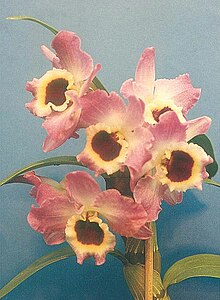
Cymbidium, commonly known as boat orchids, is a genus of evergreen flowering plants in the orchid family Orchidaceae. Orchids in this genus are epiphytic, lithophytic, terrestrial or rarely leafless saprophytic herbs usually with pseudobulbs. There are usually between three and twelve leaves arranged in two ranks on each pseudobulb or shoot and lasting for several years. From one to a large number of flowers are arranged on an unbranched flowering stem arising from the base of the pseudobulb. The sepals and petals are all free from and similar to each other. The labellum is significantly different from the other petals and the sepals and has three lobes. There are about fifty-five species and sixteen further natural hybrids occurring in the wild from tropical and subtropical Asia to Australia. Cymbidiums are well known in horticulture and many cultivars have been developed.

Dendrobium nobile, commonly known as the noble dendrobium, is a member of the family Orchidaceae. It has become a popular cultivated decorative house plant, because it produces colourful blooms in winter and spring, at a time when little else is in flower. It is also one of the 50 fundamental herbs used in traditional Chinese medicine, known as shí hú or shí hú lán. Dendrobium nobile is one of the most widespread ornamental members of the orchid family. Its blooms are variegated in colour, shading from white through pink and purple, and the many different cultivated varieties produce different sized and coloured blooms.

Dendrobium bigibbum, commonly known as the Cooktown orchid or mauve butterfly orchid, is an epiphytic or lithophytic orchid in the family Orchidaceae. It has cylindrical pseudobulbs, each with between three and five green or purplish leaves and arching flowering stems with up to twenty, usually lilac-purple flowers. It occurs in tropical North Queensland, Australia and New Guinea.

Dendrobium discolor, commonly known as antler orchid or golden orchid, is a species of epiphytic or lithophytic orchid in the family Orchidaceae, and are native to northern Australia, New Guinea, and part of Indonesia. It has cylindrical pseudobulbs, each with between ten and thirty five leathery leaves, and flowering stems with up to forty mostly brownish or greenish flowers with wavy and twisted sepals and petals.
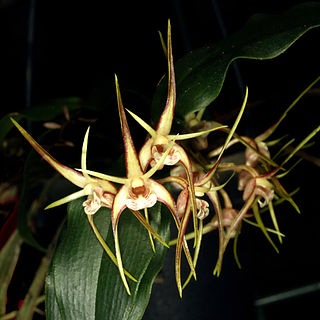
Dendrobium tetragonum, commonly known as the tree spider orchid, is a variable species of epiphytic or lithophytic orchid endemic to eastern Australia. Tree spider orchids are unusual in having pendulous pseudobulbs that are thin and wiry near the base then expand into a fleshy, four-sided upper section before tapering at the tip. There are only a few thin but leathery leaves at the end of the pseudobulbs and up to five flowers on relatively short flowering stems. To allow for the variations in the species there are five subspecies and a variety, some with a unique common name.
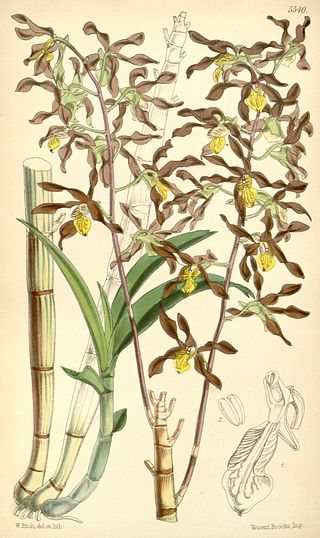
Dendrobium johannis, commonly known as the chocolate tea tree orchid, is a species of epiphytic or lithophytic orchid native to Australia and New Guinea. It has spindle-shaped pseudobulbs, between five and ten dark green leaves with purplish markings and flowering stems with up to fifteen chocolate brown flowers with a yellow labellum.

Taeniophyllum, commonly known as ribbon roots or 带叶兰属 is a genus of about 240 species of epiphytic or lithophytic plants from the orchid family, Orchidaceae. Plants in this genus are more or less leafless with a very short stem and roots that are often flat, green and photosynthetic. The flowers are small, short-lived, flat or tube-shaped and arranged on short, thin flowering stems. Orchids in this genus are found in Africa, tropical and subtropical Asia, New Guinea, Australia and some Western Pacific Islands. It is extinct in Malawi.

Oberonia, commonly known as fairy orchids, is a genus of flowering plants in the family Orchidaceae. Orchids in this genus are epiphytic or lithophytic plants with the leaves arranged fan-like, overlapping at the base and spreading near the tips. Large numbers of tiny, short-lived, cup-shaped, non-resupinate flowers are arranged on an arching flowering stem that emerges from the base of the uppermost leaf. There are about 270 species occurring from tropical and southern Africa to the Pacific.

Plectorrhiza, commonly known as tangle orchids, is a genus of three species of flowering plants from the orchid family, Orchidaceae and is endemic to Australia. Orchids in the genus Plectorrhiza are epiphytic or lithophytic herbs with short stems, long, tangled roots, short leathery leaves and small flowers on a short, thin flowering stem. Two species occur in eastern Australia and one is endemic to Lord Howe Island.

Dendrobium moorei, commonly known as the drooping cane orchid, is a species of epiphytic or lithophytic orchid in the family Orchidaceae and is endemic to Lord Howe Island. It has cylindrical pseudobulbs, leathery, dark green leaves and between two and fifteen small, white drooping flowers that do not open widely.
Dendrobium macropus, commonly known as the Norfolk Island cane orchid, is a species of epiphytic or lithophytic orchid in the family Orchidaceae and is endemic to Norfolk Island. It has cylindrical pseudobulbs, thin, dark green leaves and between five and ten yellowish green flowers that do not open widely.
Dendrobium brachypus, commonly known as the dwarf cane orchid, is an epiphytic or lithophytic orchid in the family Orchidaceae. It has crowded, yellowish green pseudobulbs, dark green leaves and two or three cream-coloured to whitish or greenish flowers which often do not open fully. It grows on trees and rocks on one mountain on Norfolk Island.
Dendrobium brevicaudum, commonly known as the Mount Finnigan pencil orchid, is an epiphytic or lithophytic orchid in the family Orchidaceae and is endemic to Queensland. It has hanging stems, cylindrical leaves and groups of about six yellowish or orange-brown flowers with red streaks and a white labellum. It is only known from two mountainous areas north of Cairns.

Dendrobium baileyi, commonly known as the blotched gemini orchid, is an epiphytic or lithophytic orchid in the family Orchidaceae and has arching stems and flowering stems with one or two spidery, yellow flowers with dark purple spots emerging from leaf axis. It grows in tropical North Queensland, New Guinea and the Solomon Islands.

Dendrobium densiflorum is a species of epiphytic or lithophytic orchid, native to Asia. It has club-shaped stems, three or four leathery leaves and densely flowered, hanging bunches of relatively large pale yellow and golden yellow flowers.
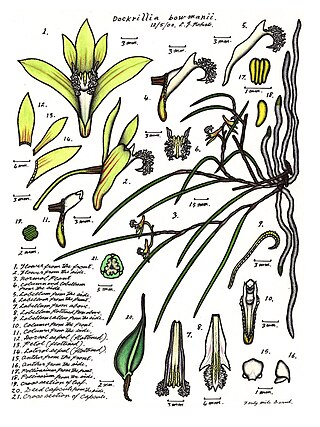
Dendrobium bowmanii, commonly known as the straggly pencil orchid, is an epiphytic or lithophytic orchid in the family Orchidaceae. It has thin wiry, straggly stems with a small number of small leaves and up to four greenish or brownish flowers with a conspicuous white labellum. It grows in drier rainforests and coastal scrub in New South Wales, southern Queensland and New Caledonia.

Dendrobium canaliculatum, commonly known as the brown tea tree orchid or thin tea tree orchid, is an epiphytic or lithophytic orchid in the family Orchidaceae. It has cone-shaped or onion-shaped pseudobulbs, up to six deeply channelled, dark green leaves and up to thirty star-shaped, light brown to caramel-coloured white or greenish to apricot-coloured flowers with darker tips. It grows in tropical North Queensland and New Guinea.

Dendrobium fleckeri, commonly known as the apricot cane orchid, is a species of epiphytic or lithophytic orchid endemic to far north Queensland, Australia. It has cylindrical pseudobulbs with two or three dark green leaves and up to four apricot-coloured or yellowish green flowers with tangled white hairs on the edge of the labellum.
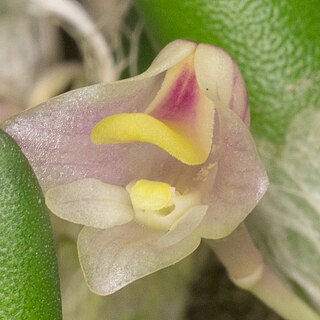
Dendrobium lichenastrum, commonly known as the common button orchid, is a species of epiphytic or lithophytic orchid endemic to far north Queensland. It has a creeping, branching rhizome surrounded by papery bracts, small egg-shaped to round, fleshy, dark green leaves and a single white, cream-coloured or pink flower with red stripes and an orange labellum.

Dendrobium nindii, commonly known as the blue antler orchid, is an epiphytic or lithophytic orchid in the family Orchidaceae. It has erect, cylindrical, leafy pseudobulbs with leathery, dark green leaves and up to twenty mauve or violet flowers with darker veins on the labellum. This antler orchid occurs in tropical North Queensland and New Guinea.


